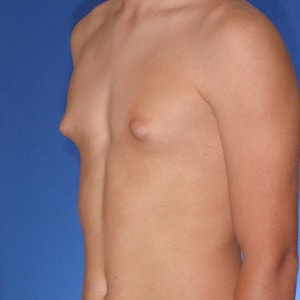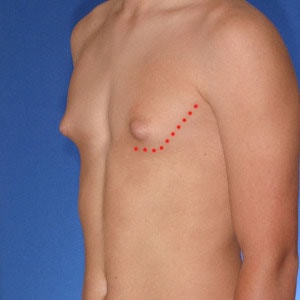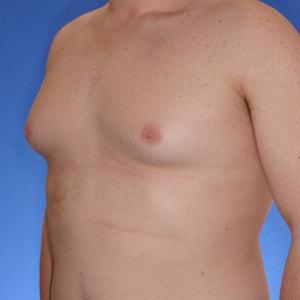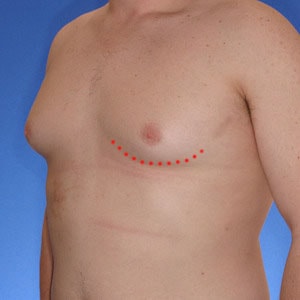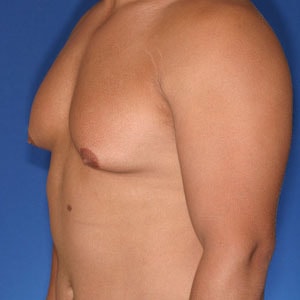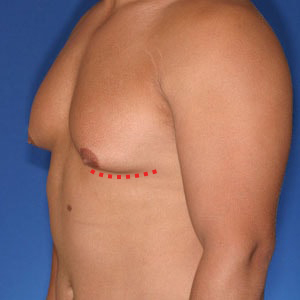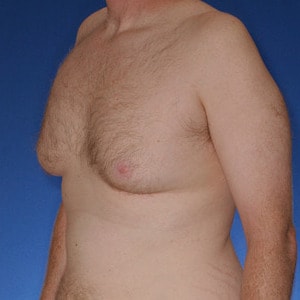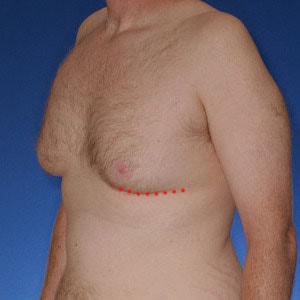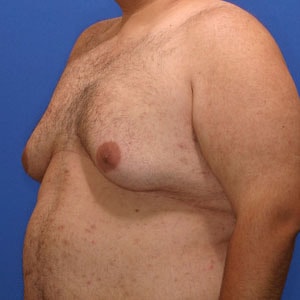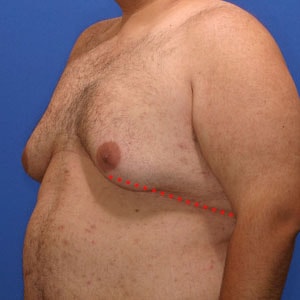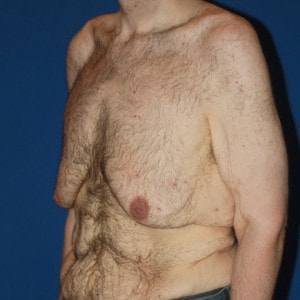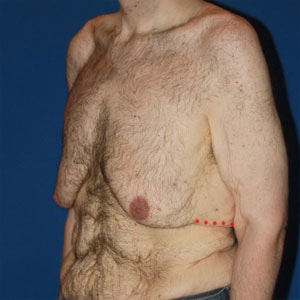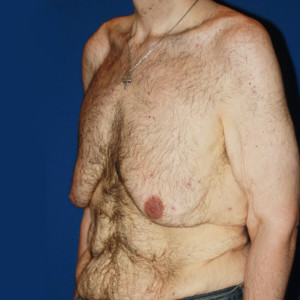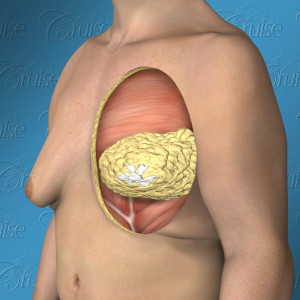Type 6 Gynecomastia - Breast Roll with Back Roll
1. Overview
Average cost: $15,500-$18,000
Recovery: 3 – 4 days sedentary work, 3-6 weeks heavy labor
3. Anatomy of Type 6
Firm, white, glandular tissue located almost exclusively underneath the nipple/areola
Type 6 Overview
Breast Roll with Back Roll
Definition
Breast tissue – extends into the armpit and around the back
Nipple position – > 2 cm below the chest fold
Chest fold shape – significant skin excess, breast roll extends around to the back, severe breast sag, no definition.
Most common demographic – no defined age group, history of obesity, massive weight loss
Characterized by severe breast sag and breast tissue which extends into the arm pit and around the back creating a breast roll with back roll.
Surgery Information
Anesthesia: Typically performed under general anesthesia.
Cost: $15,500 – $18,000.
Consultation fee: Charged upon scheduling a consultation.
Recovery: 3 – 4 days for sedentary work, 4-6 weeks if job requires heavy labor.
Cruise Classification System
Based on over 2500 gynecomastia surgeries, Dr. Cruise has classified gynecomastia into 6 different types. Each type is unique in its own way and must be treated differently. The purpose of the Cruise Classification System is to:
- Classify gynecomastia type
- Define patient goals
- Outline optimal treatment plan
“A classification system is only useful if it outlines a treatment plan.”
– Dr. Cruise
Cruise Classification System – 6 Types of Gynecomastia
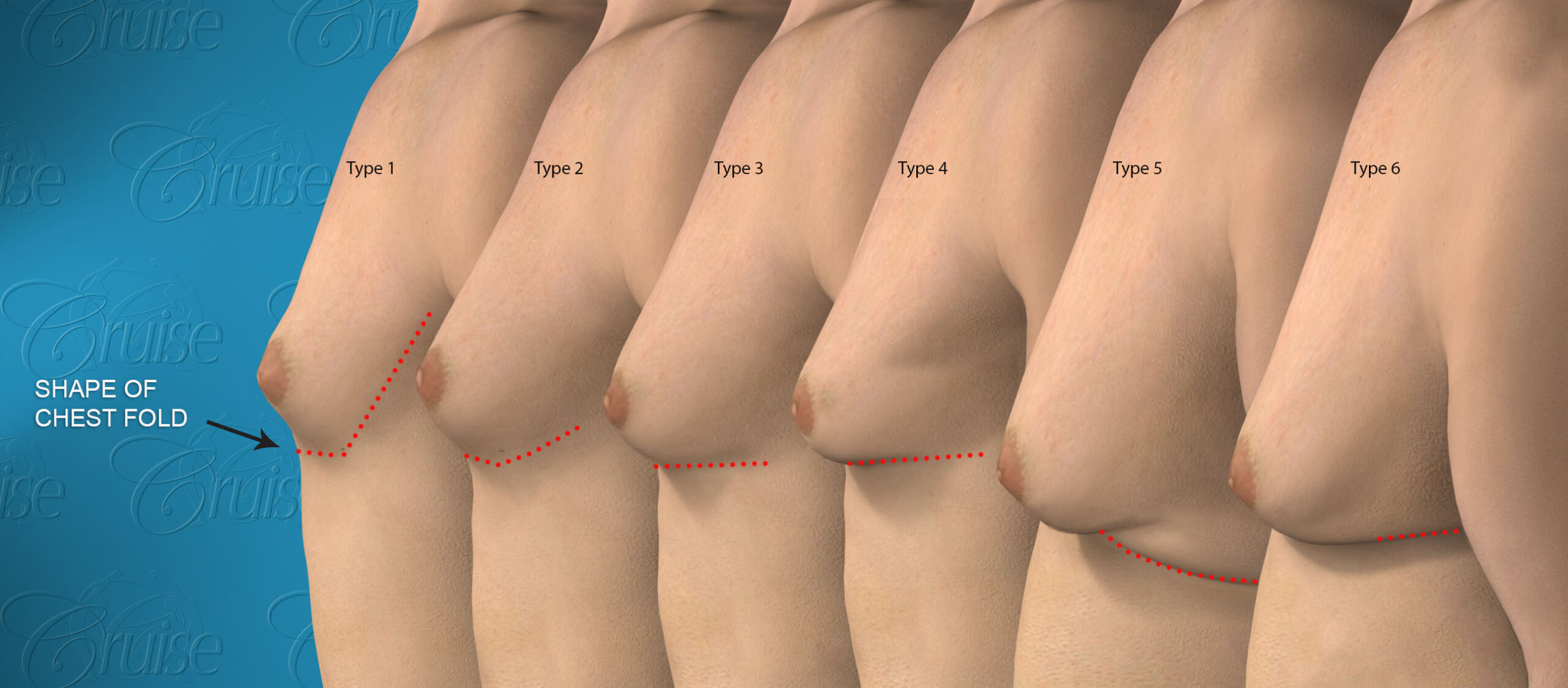
Notice the progressive increase in skin laxity. This excess skin will change the type of surgery necessary to properly correct the problem.
-
Type 1
Breast tissue – under nipple/areola only
Nipple position – above border of pec. muscle
Lateral chest fold – tight, straight
-
Type 2
Breast tissue – extends over chest fold
Nipple position – above border of pec. muscle
Lateral chest fold – tight, rounded
-
Type 3
Breast tissue – extends over chest fold
Nipple position – 0 to 2 cm. below border of pec. muscle
Lateral chest fold – mild laxity, horizontal
-
Type 4
Breast tissue – extends into axilla
Nipple position – >1.5 cm below border of pec. muscle
Lateral chest fold – small breast roll in front of arm pit
-
Type 5
Breast tissue – extends into axilla
Nipple position – ≥ 2 cm below border of pec. muscle
Lateral chest fold – breast roll extends to the back of arm pit
-
Type 6
Breast tissue – extends into axilla
Nipple position – ≥ 2cm below border of pec. muscle
Lateral chest fold – breast roll extends around to back
What is Type 6 Gynecomastia?
Type 6 Gynecomastia, by definition, has so much excess skin that it creates a breast roll that extend onto the back creating a “back roll”. Like type 5 there is usually excess skin in “two directions”. (See type 5). Proper treatment requires addressing both the excess tissue and excess skin in all directions. This is necessary to not only create a defined chest and sculpted arm pit, but to create a long term V shape to the upper body.
Anatomy of Type 6 Gynecomastia
Typical external appearance
What's going on underneath
Optimal Results for Type 6
Unfortunately, the clinical definition for optimal results is virtually non-existent; even in plastic surgery literature. This is why it was essential for Dr. Cruise to include it as part of the Cruise Classification System. A classification system is only useful if it identifies where you are and where you need to go.
The first part of the classification system identifies 6 basic types based on where you are. This next part of the system identifies where you need to go. It is true, different men have different goals. However, with Type 6 patients it is critical to achieve the absolute best long term result possible. Dr. Cruise’s has identified eight fundamental aspects of the male upper chest that need to be evaluated in order to achieve a masculine chest. These eight are outlined below.
- Read more...
Type 6 patients need to address all eight components. All of them are critical to achieve optimal results. With Type 6 it takes considerable planning and experience combined with dramatic skin removal and re-positioning. However, the upside is equally as dramatic. By the time you get to Type 6, minimizing incisions has gone out the window. However, with Dr. Cruise, making them fade away has not. As hard as it may be to believe, the goal is still to allow you to comfortably take your shirt off in public. Incisions get better every day but skin sag only keeps getting worse. With this in mind, chest shape and tight skin is critical. Proper evaluation and treatment of components 4-7 are essential to achieve a sculpted arm pit or even seeing the outline of your pec. major and lat. dorsi. This, however, is what the art of gynecomastia surgery is all about. Meticulously evaluating and addressing these components is what separates you from over-sized to fitted shirts. Determining your goals while addressing these components is what determines your surgical road map.
Anatomy of a Masculine Chest
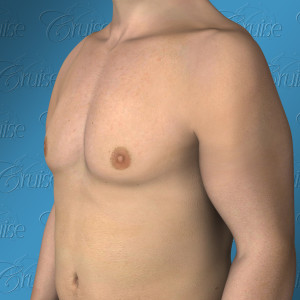
External view of optimal result
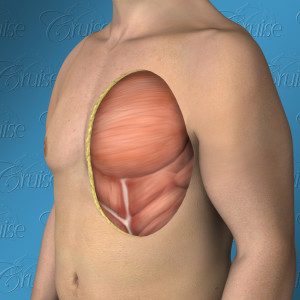
Inside view of optimal result
What defines “Optimal Results?”
The Cruise classification accurately defines “where you are”. Now, we need to clearly define in surgical terms “where you want to go.”
With this is mind, we asked Dr. Cruise to outline the most important aspects that need to be addressed when surgically treating gynecomastia and what they should ideally look like.
Eight Components
-
1. Chest shape - masculine, flat and defined
Overall, a masculine chest is full and powerful above the nipple but ripped and defined below. The key is to create muscle definition, flatten the nipple, yet keep the chest area above the areola normal thickness. Thinning too much will create a “fragile” appearance and worse, may create contour irregularities. The goal is to flatten the chest so that you can confidently wear tight white T-shirts and to create a V shape from both the back and front view.
-
2. Nipple position
While most gynecomastia patients are looking for a “flat” chest what they really mean is they want a masculine chest. There is a difference. Overall, a masculine chest is flat with a defined pec. major muscle. The upper chest should remain full and powerful. The goal is to create a sculpted look by getting the nipple to lay flat against the pec. major muscle and by getting the the skin to wrap around the border of the muscle into a sculpted axilla.
-
3. Areola size, projection and shape
The areola is the dark, pigmented skin around the nipple. Areola size is proportionate to chest size. Ideally, it should 25-35 mm and lay flush with the surrounding skin. However, slight elevation is common. Most people do not consciously realize it but areolas are usually wider than they are tall. A perfectly round areola is not ideal and an areola that is taller than it is wide may even appear unusual or “surgical”. This is particularly relevant with Types 4, 5 and 6 which usually require reducing and re-positioning the nipple with a free nipple graft. A protruding nipple is common with puffy nipple due to the pressure from the swollen breast tissue below. However, there are situations where the nipple is simply enlarged. Fortunately, reducing the nipple by excision is straight forward, low cost, little down time and very effective.
-
4. Pec. border definition
Ideally, the pectoralis major muscle should be defined and straight with the skin wrapping around it into a well defined chest fold and then into a defined arm pit hollow. Excess breast tissue, fat and/or saggy skin will blur this border and create a round, feminine appearance.
-
5. Arm pit
Should have sculpted appearance with a well define hollow at its apex. The borders of the pec. major in front and the latissimus dorsi in back should be well defined giving a V shape to the upper body. Excess fat/saggy skin can fill the arm pit creating an uncomfortable fullness in armpit and a saggy breast roll just below. For types 5 and 6’s, this is often as big of a concern as the chest. Creating a sculpted axilla and a V shape appearance to the upper body is one of the most rewarding parts of gynecomastia surgery yet it is usually overlooked as not being part of the gynecomastia. It is important for your surgeon to understand that the goal of surgery is to create a V shaped, masculine chest and not just to remove breast tissue. While this is true for all types it is particularly relevant for types 4,5 and 6. I can not tell you have powerful the results are when you create a sculpted pec., lat. and arm pit. It is truly life changing.
-
6. Three Fat pockets – pre-axillary, axillary and breast roll
Ideally, there should not be any fat pockets. There are three common fat pockets that need to be evaluated and removed if present:
- Pre-axillary fat – located just in front of the armpit.
- Axillary fat – located within the arm pit itself and
- Breast roll fat – located just below the arm pit and creates a fullness or breast roll. It blurs pec., arm pit and lateral definition and disrupts V shape and the upper body that defines masculinity.
-
7. Breast rolls
Should not be present. Lateral chest/arm pit skin should be tight enough to prevent breast rolls, create a defined pec. border and lat. border with a sculpted arm pit in between. Breast rolls represent saggy skin under the arm pit. Flattening the chest and not correcting breast rolls actually makes the breast rolls more noticeable and creates a disproportionate look to the upper body.
-
8. Back rolls
Should not be present. They represent saggy skin that goes all the way around to the back. Optimal surgical treatment requires removing all the excess skin in a 360 degree fashion. Often seen with massive weight loss patients.
Surgical Treatment Options
Below find Dr. Cruise’s preferred incision placement for effectively treating Type 6 Gynecomastia.
Type 6 Incisions - Upper Body Lift
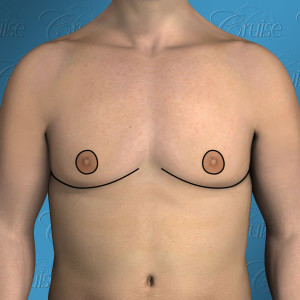
Front view
Chest lift with nipple re-positioning (pedicle) or free nipple graft. Incision is positioned strategically within the natural chest fold. Type 6 Gynecomastia patients have massive amounts of excess skin in multiple directions. Optimal correction requires removing all the excess skin and re-positioning the nipple on top of the pec. major muscle where it belongs. The incisions on the chest are similar to the Type 5 chest lift. The circular nipple/areola incision routinely heals exceptionally well because it is not under tension. The chest fold incision is well hidden in the chest fold before it circles around to the back. This is the incision that takes the longest to fade; usually 1-2 years. This incision may go completely around the back or it may end over the scapula depending on if there is excess skin in the mid-line back.
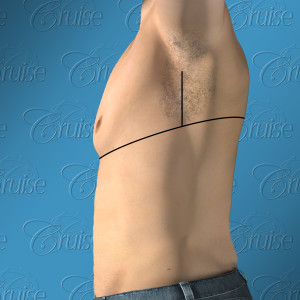
Lateral view
This Shows the extended incision rising in straight line across the axilla onto the back. Arm pit incision represents axillary. This bi-directional incision arrangement allows skin tightening in all directions. The axillary pleat is an amazing addition to both Type 5 and 6’s. It tightens the skin horizontally creating a sculpted arm pit, a defined pec. major and lat. dorsi as well as creating a V-shape to the back.
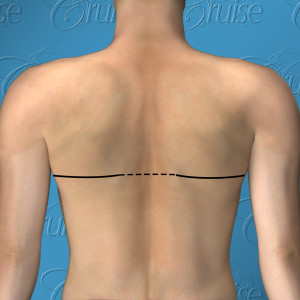
Back view
Incision goes as far a the back roll goes. This may or may not require a circumferential incision (This is represented by dotted line.)
Nipple Re-Positioning or Free Nipple Graft vs Anchor Lift
In short, for the vast majority of patients, the Nipple Re-Positioning or Free Nipple Graft is a significantly better procedure than the traditional Anchor Lift. The 4 main reasons are;
- The incision around the areola routinely becomes unnoticeable with the free nipple graft,
- There is no vertical incision below the areola,
- It reliably provides a flatter, more masculine result, and
- Contrary to what I initially thought, I have had far less complications.
- Read more...
The only reason why the anchor lift is common in traditional gynecomastia surgery is because it is the most common procedure in female breast lifts. However, men and women are different. I know this seems almost comical but it has to be explained. The anchor lift is a great procedure when the goal is to create a perky, conical breast. I use it all the time on my female breast lifts – but never for men. The last thing I want to accomplish is a perky, conical chest on my gynecomastia patients. I switched over to the Nipple Re-Positining/Free Nipple Graft 10 years and several thousand gynecomastia patients ago and have never looked back. I did it originally to avoid the unsightly vertical scar (ironically this vertical scar heals extremely well in women but not with men because of incisional tension reasons.) I did not expect to find that not only did the Nipple Re-positioning/FNG method avoid the vertical incision; it made the incision around the areola virtually unnoticeable with time. Again, the reason is because there is no tension.
Anchor Lift Incisions vs Free Nipple Graft Incisions
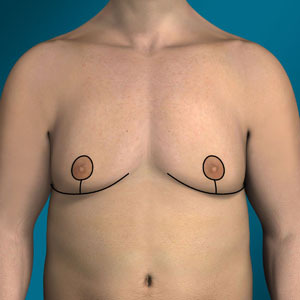
Anchor lift
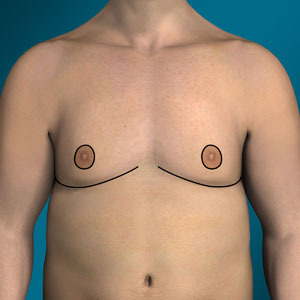
Nipple re-positioning/Free nipple graft
No vertical incision from areola to breast fold
Difference in Result
Anchor Lift & Nipple Re-positioning /Free Nipple Graft
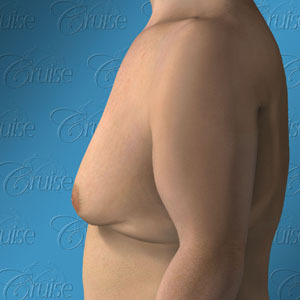
Before
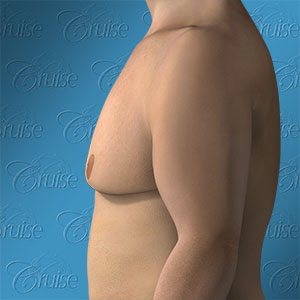
After anchor lift
Notice the persistent breast fullness as well as skin sag that can not be corrected as well as with free nipple graft.
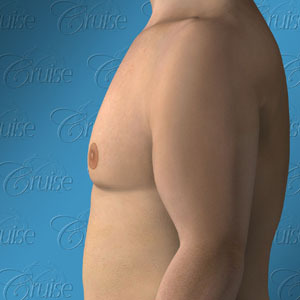
After nipple re-positioning/ free nipple graft
Notice that those incisions will typically provide a tighter and flatter chest than anchor lift with better scarring.
Click the image below to view a complete timeline of the Type 6 gynecomastia recovery process. Gaining a better understanding about what to expect will help you properly prepare, plan, and reduce stress.
Everything you need to know about your recovery
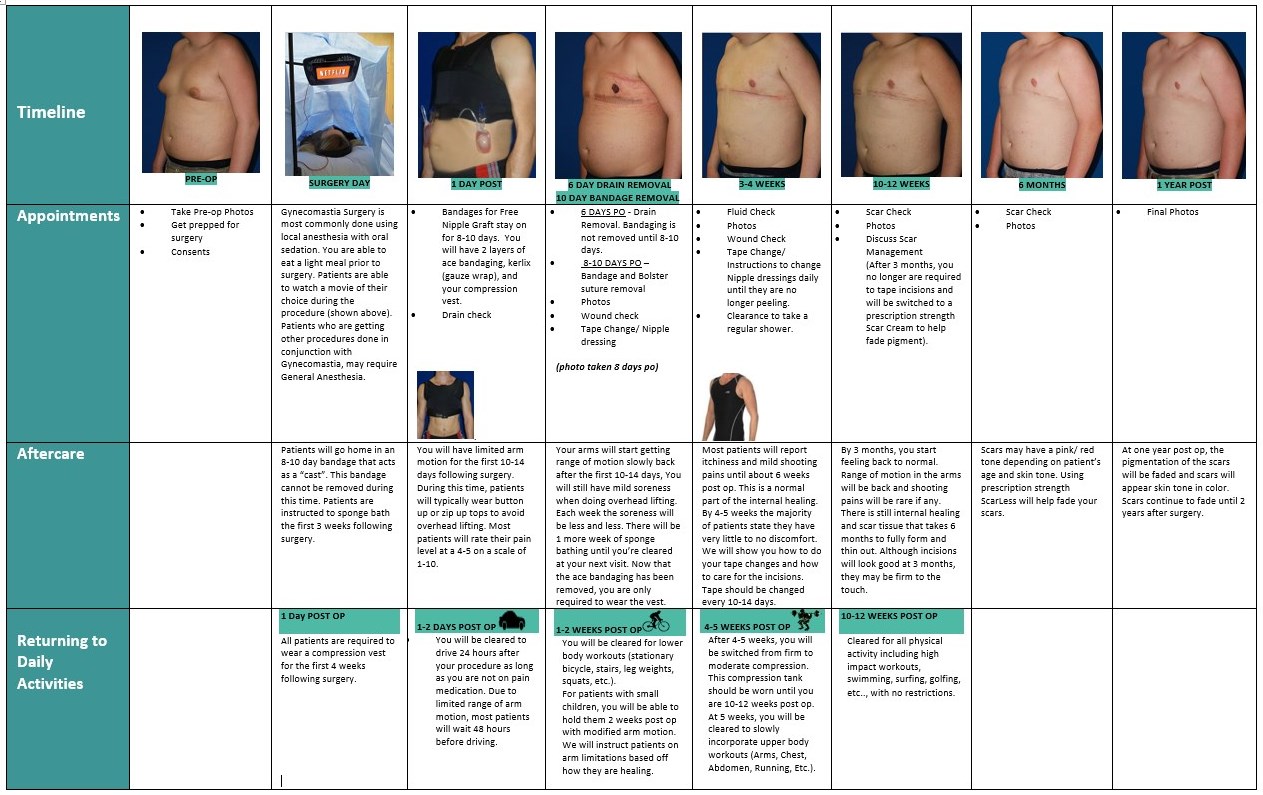
Gynecomastia Before & After Photos
View before and after photos to see the results of Type 6 Gynecomastia. Remember, each patient is unique and results will vary from patient to patient.
Emotional Cost of Gynecomastia
The pain and suffering associated with gynecomastia is unlike any other condition in plastic surgery and perhaps in all of medicine. The range of its impact is stunning. Some men (usually older) can be relatively unaffected while others (usually the younger) can be completely devastated and even suicidal.
- Read more...
Unfortunately, because of the stigma associated with it, it is not always readily apparent what your loved one may be experiencing. In fact, the men or more commonly pubescent teenagers, who are most deeply affected go to great lengths to suffer alone. The Internet becomes the only one they can talk to. This dangerous combination of deep emotional pain and isolation makes them particularly vulnerable to exploitation. Exploitation that takes the form of the literally thousands of “miracle” cures that have no medical merit to the more nefarious types looking to take advantage of the the emotionally weak.
Patient Perspective – common feelings associated with patients who have Type 6 Gynecomastia:
- Frustrated massive weight loss left him with extremely saggy breasts. Not sure if the weight was worse or the breasts are worse.
- Still can’t wear anything but baggy clothing.
- Wide spectrum of outward expression from normal to:
- Hunched neck and shoulders.
- Downward gazing head/eyes.
- Uncomfortable with eye contact.
- Trapped in a foreign body he doesn’t recognize.
- Overwhelming feeling of helplessness.
- Self-image has hit rock bottom.
- Negative impact on other aspects of life including relationships, career motivation, health/exercise, social life
Schedule a Consultation
Call our office today, (949) 644-4808, or fill out our online contact form to learn more about gynecomastia and what your surgical options are. Dr. Cruise has performed over 5,000 gynecomastia surgeries and is ready to meet you for a consultation.

